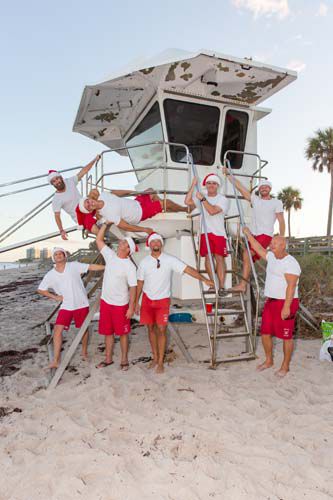Vero Beach lifeguards are gearing up for another busy season, anticipating beaches filled with year-round residents, holiday visitors and returning snowbirds enjoying what the Old Farmer’s Almanac predicts will be a milder than normal winter.
“Crowds are starting to come,” said Vero Beach Lifeguard Association President Eric Toomsoo.
The nonprofit VBLA was formed in 2011 and is comprised of lifeguards, residents and businesses concerned with promoting lifeguarding and water safety. Adhering to that mission, the VBLA raises funds and awareness in an effort keep our local beaches, the area’s No. 1 attraction, well-equipped and well-protected.
“One of the projects we’re working on right now is we’re about to release the area’s first-ever water safety video,” said Toomsoo, noting that the free video will be made available to the public on their VBLA.org website. They hope to release the video shortly after the new year and envision it as something that could be broadcast on local access channels at area hotels so that guests know a little about our waters, particularly rip currents, before venturing out.
They plan to give copies to all the schools and Toomsoo adds, “We also have a mermaid, Teale the Mermaid, who is one of our lifeguards. She will go to the schools using the video to teach kids about water safety. It was shot right here in Vero. Jeff Zachery is producing it with lifeguard Todd Rapp as executive producer.”
Additionally, the group is actively fundraising to erect a lifeguard tower and headquarters at Humiston Beach, to replace the current small shack on the boardwalk. They are waiting for approval from the Department of Environmental Protection and will then need approval from the City of Vero Beach.
“That’s our big thing,” said Toomsoo. “Vero Beach had the first House of Refuge on the whole east coast of Florida in 1876, right here at Jaycee Park. We want the design of the tower to look like the old Houses of Refuge that we had along our coast. So it will have a functional aspect but also a historical significance.”
Plans call for the lower floor to house administrative offices, with the second floor becoming a lifeguard tower, affording an enhanced, elevated view of the beach and better protection from the elements.
There were 10 Houses of Refuge, or life-saving stations along the Atlantic coast of Florida, each staffed by keepers and their families to assist victims shipwrecked on the ocean’s hidden reefs. They were run by the U.S. Life-Saving Service, which in 1915 became the U.S. Coast Guard. The first one built was the Bethel Creek House of Refuge and the only one remaining is the House of Refuge on Gilbert’s Bar, now a museum on Hutchinson Island in Stuart.

